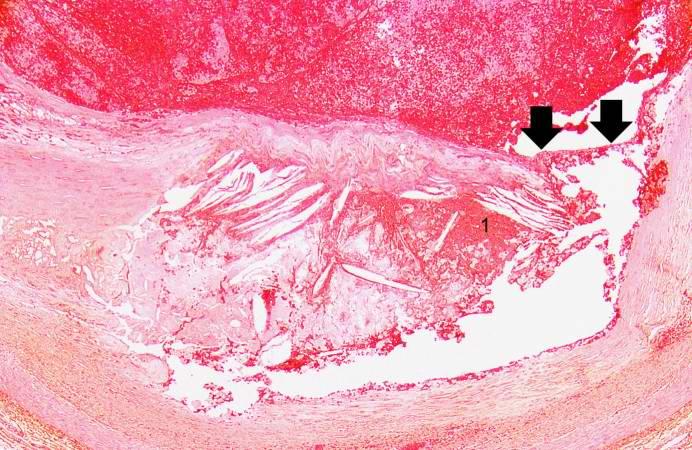Unstable angina / non ST elevation myocardial infarction diagnosis
| Unstable angina pectoris | |
 | |
|---|---|
| Plaque rupture in a coronary artery at arrows yielding obstructive thrombus in red. Image courtesy of Professor Peter Anderson DVM PhD and published with permission © PEIR, University of Alabama at Birmingham, Department of Pathology | |
| ICD-10 | I20 |
| ICD-9 | 413 |
| DiseasesDB | 8695 |
| eMedicine | med/133 |
| MeSH | D000787 |
| Cardiology Network |
 Discuss Unstable angina / non ST elevation myocardial infarction diagnosis further in the WikiDoc Cardiology Network |
| Adult Congenital |
|---|
| Biomarkers |
| Cardiac Rehabilitation |
| Congestive Heart Failure |
| CT Angiography |
| Echocardiography |
| Electrophysiology |
| Cardiology General |
| Genetics |
| Health Economics |
| Hypertension |
| Interventional Cardiology |
| MRI |
| Nuclear Cardiology |
| Peripheral Arterial Disease |
| Prevention |
| Public Policy |
| Pulmonary Embolism |
| Stable Angina |
| Valvular Heart Disease |
| Vascular Medicine |
Template:WikiDoc Cardiology News Editor-In-Chief: C. Michael Gibson, M.S., M.D. [1]
Associate Editor-In-Chief: Cafer Zorkun, M.D., Ph.D. [2]
Please Join in Editing This Page and Apply to be an Editor-In-Chief for this topic: There can be one or more than one Editor-In-Chief. You may also apply to be an Associate Editor-In-Chief of one of the subtopics below. Please mail us [3] to indicate your interest in serving either as an Editor-In-Chief of the entire topic or as an Associate Editor-In-Chief for a subtopic. Please be sure to attach your CV and or biographical sketch.
Synonyms and related keywords: progressive angina, crescendo angina, accelerating angina, new-onset angina, pre-infarction angina, unstable angina pectoris, UAP, UA
Diagnosis of Unstable Angina Pectoris
Laboratory Findings
Electrolyte and Biomarker Studies
If there is an elevation of a marker of myocardial necrosis (CK-MB or troponin), then the patient does not have unstable angina, but instead has a syndrome of either ST elevation MI or Non ST elevation MI depending upon the EKG changes.
Electrocardiogram
The resting electrocardiogram may show either
- No changes
- Non specific ST T wave changes
- Flipped or inverted T waves
- ST Depression as shown below. ST depression carries the poorest prognosis. Greater magnitudes of downsloping ST depression are associated with a poorer prognosis.

Chest X Ray
A chest X-ray is critical to aid in the exclusion of aortic dissection. A mediastinal mass consistent with a cancer may be present, but it is unlikely to present with a syndrome of accelerating chest pain. The chest X ray is critical in assessing for the presence of pulmonary edema or congestive heart failure which requires urgent treatment and confers a poorer prognosis.
Echocardiography
Segmental wall motion abnormalities can occur within minutes of coronary artery occlusion and can be useful in establishing that the pain is of cardiac origin and in determining the myocardial territory that is at risk.
Coronary Angiography
An early invasive strategy including coronary angiography may be required if aggressive medical therapy fails to stabilize the patient, if prior revascularization procedures have been performed, in the presence of recurrent angina, and in the presence of abnormal non-invasive test results.
ACC / AHA Guidelines- Identification of Patients at Risk of UA/NSTEMI (DO NOT EDIT) [1]
| “ |
Class I1. Primary care providers should evaluate the presence and status of control of major risk factors for coronary heart disease (CHD) for all patients at regular intervals (approximately every 3 to 5 years). (Level of Evidence: C) 2. Ten-year risk (National Cholesterol Education Program global risk) of developing symptomatic CHD should be calculated for all patients who have 2 or more major risk factors to assess the need for primary prevention strategies (2,3). (Level of Evidence: B) 3. Patients with established CHD should be identified for secondary prevention efforts, and patients with a CHD risk equivalent (e.g., atherosclerosis in other vascular beds, diabetes mellitus, chronic kidney disease, or 10-year risk greater than 20% as calculated by Framingham equations) should receive equally intensive risk factor intervention as those with clinically apparent CHD. (Level of Evidence: A) |
” |
Sources
- The ACC/AHA 2007 Guidelines for the Management of Patients With Unstable Angina/Non-ST-Elevation Myocardial Infarction [1]
References
- ↑ 1.0 1.1 Anderson JL, Adams CD, Antman EM; et al. (2007). "ACC/AHA 2007 guidelines for the management of patients with unstable angina/non-ST-Elevation myocardial infarction: a report of the American College of Cardiology/American Heart Association Task Force on Practice Guidelines (Writing Committee to Revise the 2002 Guidelines for the Management of Patients With Unstable Angina/Non-ST-Elevation Myocardial Infarction) developed in collaboration with the American College of Emergency Physicians, the Society for Cardiovascular Angiography and Interventions, and the Society of Thoracic Surgeons endorsed by the American Association of Cardiovascular and Pulmonary Rehabilitation and the Society for Academic Emergency Medicine". JACC. 50 (7): e1–e157. PMID 17692738. Text "doi:10.1016/j.jacc.2007.02.013 " ignored (help); Unknown parameter
|month=ignored (help)